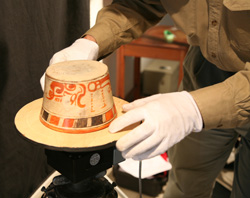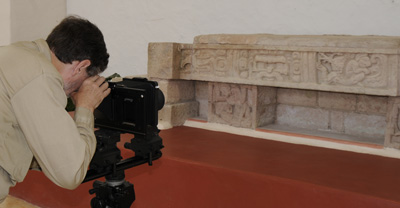The Foundation for Latin American Anthropological Research (FLAAR.)
Contact: Dr Nicholas Hellmuth, Director, e-mail [email protected]. We welcome serious inquiries about pertinent topics.
Please realize, however, that we do not have enough secretaries to do the homework of all the students who hope to do a quick job via the Internet. The information you are seeking is in books; there are countless pages of book lists on this site. You can read these books free at your nearest library or order them from www.amazon.com (the FLAAR. Book Service is still in the process of being resettled from Florida to St Louis).
If you are a museum director, curator or photographer, or corresponding digital imaging or graphics design person wishing to learn more about what equipment we have found to be best for your museum, institution, or graphics design situation, please help yourself to the full menu of links of every page. Go to the index of the digital imaging theme of your choice. After you have done some background research on those sites, feel free to e-mail us. We are able to answer about 80% of the e-mails that come in, especially if they pertain to high-end scanners, wide format digital printers, and large format photography scanning backs.
The more information you provide about your current digital imaging set up (or your needs to figure out which equipment is best for such a set up if you are new and just starting), the easier it is for us to respond to your request for guidance. Please allow an average of 2 to 3 days for us to respond; after that it probably means the staff is off at a meeting in a foreign country or on expedition, or simply overwhelmed by other e-mails. We do our best to help complete newcomers to large format printing and professional scanning but we are the wrong place to ask "what $299 scanner is best for me," or "what Epson inkjet is cheapest to print my photographs?" Our experience is primarily with equipment used in professional graphics design and regret that we are not the ideal place for suggestions on what cheap equipment is best for home or hobby.
 |
| Preparing to take pictures at La Ruta Maya Conservation Foundation |
The Foundation for Latin American Anthropological Research is a non-profit institution dedicated to advancing scholarly knowledge of ancient civilizations of the Americas and explaining these facts and artifacts to the general public. One of our many goals is to improve the quantity and quality of professional photography of Maya artifacts to preserve this heritage for future generations of students.
Donations from the general public started this Institute and keep it going. Scholarships, stipends and grants, combined with donations, have allowed FLAAR. to leave its imprint first in the obscure scholarly field of Lacandon ethnohistory, and then in the iconography of Maya art.
FLAAR., founded some 30 years ago, is international in its scope. FLAAR. has kept a major library in GRAZ, Austria, for over fifteen years. This library serves the active and capable group of Mayanists in Graz, one of Europe's centers for Maya research. We provide an extensive library in Maya ethnology, ethnohistory, epigraphy, linguistics, ancient art and archaeology for the Museo Popol Vuh of the Universidad Francisco Marroquin, in Guatemala City. This library has been on loan to the museum for over 17 years, providing students and scholars in Central America the access that they deserve to worldwide publications about their own country.
The third of FLAAR.'s research libraries is housed in the USA. This is one of the four largest libraries on pre-Columbian topics in Florida. This library covers the Olmec, Teotihuacan, and all the other civilizations from the Aztec to the Zapotec. This is a full-scale in-house research library, not a loaning library. In order to make books available for others, we have a separate Art & Archaeology Book Service.
FLAAR. also publishes monographs and other scholarly reports on the pre-Colombian Maya culture. In addition to selling our own publications we also specialize in making hard-to-find books from obscure foreign publishers available to students and scholars in America.
The FLAAR. Director, Dr. Nicholas Hellmuth, was honored with an appointment as Visiting Professor at the National Museum of Ethnology, Osaka, Japan and previously served as a consultant for this prestigious museum. This museum has no antiquities and no artifacts whatsoever from Guatemala, Mexico, Honduras, or El Salvador--it is entirely devoted to the ethnography of traditional cultures. Their recent exhibit, organized by Dr. Yoshiho Yasugi, was on native weaving and traditional clothing of the Maya of Guatemala and Mexico.
Dr. Yasugi is an accomplished Mayan linguist, and as such has dedicated himself also to the study of Classic Mayan hieroglyphic writing. Dr. Hellmuth works with the museum on digitizing and imaging (scanning photographs of ancient hieroglyphic texts, for example, and then enhancing the images to make the faded texts more legible).
FLAAR. also does much of the photography for Dr Yasugi's publications, most recently on cacao and chocolate. In appreciation for all the help we have received from the Japanese we have made a selected 25% of the archive available to the professors and students who do research through their national museum system. We are currently finishing editing and production of a monumental new book on Maya ceramic art. This coffee table book discusses the aesthetics of Maya art, style, iconography, and features many previously unpublished hieroglyphic inscriptions.
We were the first research institution to utilize AutoCAD software to help record Maya architecture - actually inside an 8th century Maya palace (at Santa Rosa Xtampak, Campeche).
This was before any battery-operated portable computer existed that was powerful enough to run AutoCAD out in the remote jungle. This research was initiated with donations of equipment from American Power Conversion and software from AutoDesk.
On the international scene, FLAAR. provides traveling photo exhibits and slide lectures, especially for Europe. These slide shows are in any of three languages, English, Spanish, or German (the FLAAR. Director resides in Germany, if he is not in his office or at a remote place anywhere in the world, as he is most of the time).
Since many people cannot leave their families or business--or do not wish to set foot in the jungle - we have several developed programs that will bring an archaeologist to your home town. Actually you can have Professor Hellmuth give a Living Room Lecture about Maya archaeology in your own home. We also provide lectures in your company headquarters, at your school, or in your club.
If you have enjoyed the color images of the ancient Maya civilization on this Web site, just imagine what these same pictures will look like, enlarged life size, projected with a Leica or Hasselblad projector, in your school room, in your club room, in the board room of your corporation, or in your home, for you, your friends, and relatives.
Since you can learn so much more about the fascinating cultures of Mexico, Guatemala, Honduras, and Belize by visiting these countries, in the past we have organized travel programs for all ages and all backgrounds. FLAAR. has also organized archaeology tours to Peru and Bolivia.
 |
| Nicholas Hellmuth taking pictures at Copan Museum, Honduras |
Both Hellmuth and his Institute are best known among Mayanists for the extremely precise photography of Maya vases, bowls, urns, and plates. The goal of this long range program is to rescue, though photography, the figural and symbolic art of an entire civilization, and to make this available for scholarship. Entire dissertations (in Europe and in America, most notably at Yale University) have been based on the material in this remarkable research resource. FLAAR. photographs primarily in large format, both 8x10 inch (Linhof) and 4x5 inch (again Linhof). Courtesy of a magnanimous donation we now have a rollout camera.
Actually this immense archive of photographs is equally strong in records of Maya architecture, especially of the Puuc, Chenes, and Rio Bec areas. In addition to coverage of Maya art, the FLAAR. Photo Archive covers the Olmec, Teotihuacan, Aztec, Toltec, Zapotec, Mixtec, and Veracruz. Although best known for ceramics this archive is also a good source for images of jade, flint, obsidian, carved seashell and sculptured stone monuments of all sizes.
Decades of experience while photographing and doing research worldwide has resulted in being in demand for information on every imaginable topic. We were paid a handsome sum for developing packaging, logo, and ad copy for a major Mexican corporation which wanted to launch a product in the United States. They wanted an enticing pre-Columbian image for their beverage. FLAAR.
frequently receives requests for professional consulting services, especially from museums, television, Hollywood, news organizations, and of course companies interested in promoting travel to archaeological or ethnographic destinations.